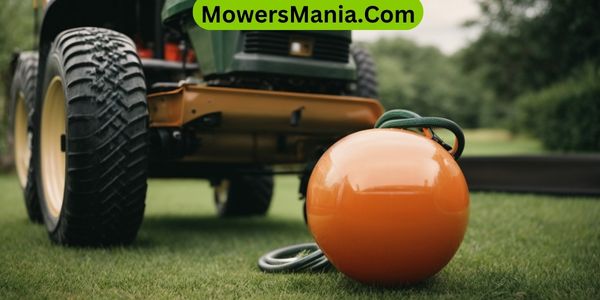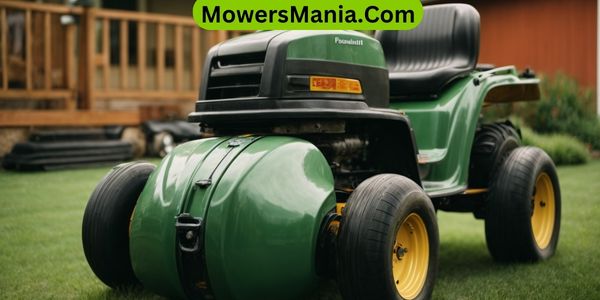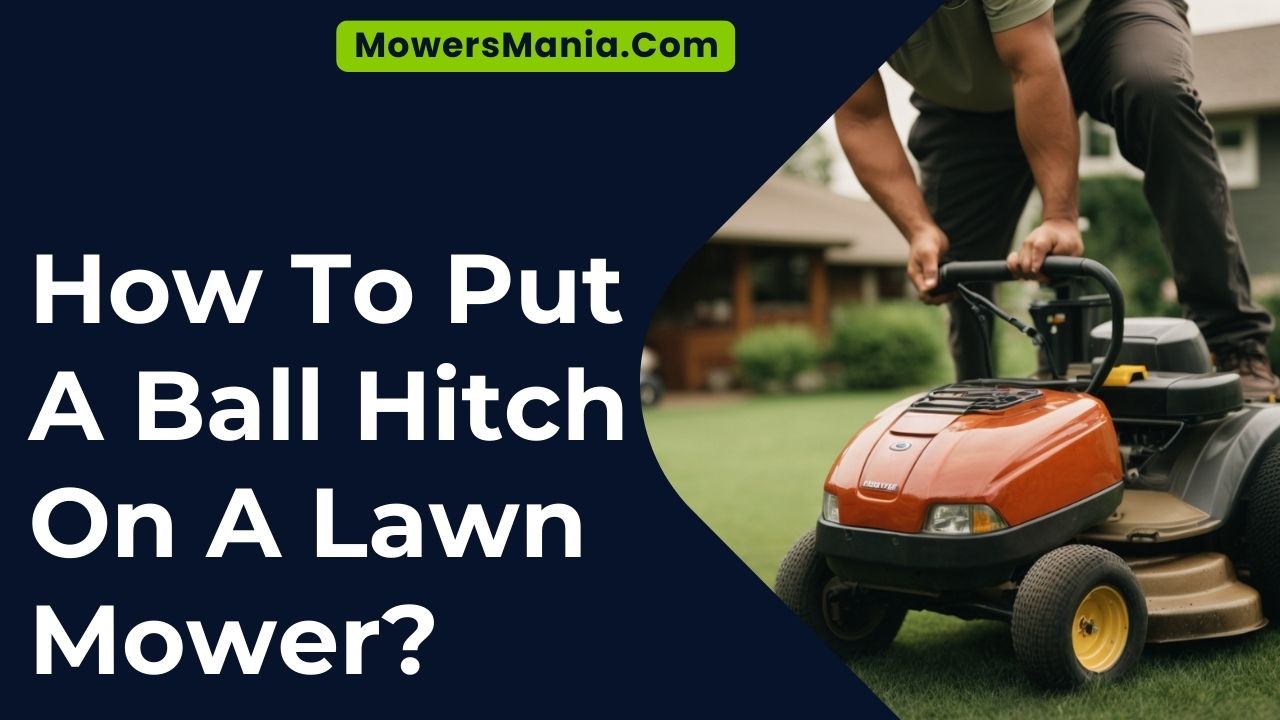Are you looking to add a ball hitch to your lawn mower? In this article, we’ll show you how to do just that.
You’ll gather the necessary tools and materials, locate the mounting point on your mower, and attach the ball hitch securely.

With these simple steps, you’ll have a functional and stable ball hitch ready for all your towing needs in no time.
Let’s get started!
Gather the Necessary Tools and Materials
To begin, gather all the essential tools and materials needed for installing a ball hitch on your lawn mower.
First, make sure you have a ball hitch kit, which typically includes the ball hitch itself, a mounting plate, and all the necessary hardware.
You’ll also need a drill, drill bits, and a wrench to secure the hitch to your mower. Additionally, have a measuring tape handy to ensure accurate placement of the hitch.
Next, gather safety equipment such as gloves and safety goggles to protect yourself during the installation process. It’s important to prioritize safety while working with tools and machinery.
Furthermore, gather a level and a marker to help you position the hitch correctly. A level will ensure that the hitch is installed straight, while a marker will help you mark the drilling points accurately.
Lastly, have a friend or family member available to assist you with the installation. It’s always helpful to have an extra set of hands to hold parts in place or help with any heavy lifting.
Locate the Mounting Point on Your Lawn Mower
Now that you have gathered all the necessary tools and materials, it’s time to locate the mounting point on your lawn mower.
This is an essential step in the process of putting a ball hitch on your mower, as it will determine the stability and effectiveness of the hitch.
Here are three simple steps to help you locate the mounting point:
- Examine the rear of your lawn mower: Take a close look at the back of your mower and identify any pre-existing holes or brackets that could potentially serve as the mounting point for the ball hitch. These may vary depending on the make and model of your mower, so refer to the owner’s manual if you’re unsure.
- Measure the distance: Once you have identified a potential mounting point, measure the distance between the holes or brackets. This will help you determine the correct size of the ball hitch and ensure a proper fit.
- Clean and prepare the mounting point: Before attaching the ball hitch, make sure to clean the mounting point thoroughly. Remove any dirt, debris, or rust that may interfere with the installation process. This will ensure a secure and reliable connection between the hitch and your mower.
Attach the Ball Hitch to the Mounting Point

Once you have located the mounting point on your lawn mower, you can now attach the ball hitch for a secure connection. Start by placing the ball hitch onto the mounting point.
Make sure that the holes on the hitch line up with the holes on the mounting point. This will ensure a proper fit and prevent any wobbling or loosening while towing.
Next, insert the bolts into the holes. Tighten them using a wrench or socket set. Make sure to tighten them securely, but be careful not to overtighten and strip the threads.
Once the bolts are tightened, check the connection by gently pulling on the ball hitch. It should be firmly attached to the mounting point and not move or come loose.
If the ball hitch is securely attached, you can now test it by attaching a trailer or other towing equipment. Make sure to follow the manufacturer’s instructions for attaching the trailer and ensure that the hitch is rated for the weight of the load.
Remember to periodically check the ball hitch and mounting point for any signs of wear or loosening. It’s important to maintain a secure connection to ensure safe towing.
Secure the Ball Hitch in Place
Attach the ball hitch securely in place by tightening the bolts with a wrench or socket set. Here are three important steps to follow:
Position the ball hitch:
- Make sure the ball hitch is properly aligned with the mounting point on your lawn mower.
- It should be centered and level to ensure a secure connection.
Insert the bolts:
- Insert the bolts through the holes in the ball hitch and into the mounting point.
- Ensure that the bolts are aligned properly and securely fastened.
Tighten the bolts:
- Use a wrench or socket set to tighten the bolts.
- Make sure to tighten them firmly, but be careful not to overtighten and risk damaging the ball hitch or the mounting point.
By following these steps, you can ensure that the ball hitch is securely attached to your lawn mower. It’s important to have a secure connection to prevent any accidents or damage while towing.
Remember to check the tightness of the bolts periodically to ensure that the ball hitch remains securely in place. Now that you have securely attached the ball hitch, you’re ready to tow with confidence.
Test the Ball Hitch for Stability and Functionality

To test the stability and functionality of the ball hitch, check for any signs of movement or looseness. This step is crucial to ensure that the hitch is securely attached to your lawn mower and can handle the weight of any trailers or attachments you plan to tow.
Start by applying pressure to the hitch in different directions. Push it forward, backward, and from side to side. If you notice any excessive movement or play, this could indicate that the hitch isn’t properly secured. In such cases, you may need to reposition or tighten the hitch to eliminate any looseness.
Next, test the functionality of the ball hitch by attaching a trailer or any other towing attachment. Securely fasten the trailer to the hitch and make sure it’s properly aligned. Once everything is in place, try applying some force to the trailer.
This can be done by gently rocking it back and forth or by giving it a slight push. If the ball hitch holds the trailer securely without any signs of slipping or detachment, then it’s functioning properly.
Frequently Asked Questions [FAQs]
What Is the Maximum Weight Capacity of a Ball Hitch That Can Be Safely Attached to a Lawn Mower?
The maximum weight capacity of a ball hitch that can be safely attached to a lawn mower depends on the specific model and its towing capabilities. Check the manufacturer’s guidelines for the recommended weight limit.
Can I Use a Ball Hitch on Any Type of Lawn Mower, or Are There Specific Models That Are Compatible?
You can use a ball hitch on most lawn mowers, but there may be specific models that are compatible. Make sure to check your mower’s specifications or consult the manufacturer for guidance.
How Do I Determine the Appropriate Size of Ball Hitch to Use for My Lawn Mower?
To determine the appropriate size of ball hitch for your lawn mower, measure the diameter of the trailer coupling. Match this measurement to the corresponding ball hitch size, ensuring a secure and proper fit.
Are There Any Specific Safety Precautions I Should Take When Attaching a Ball Hitch to My Lawn Mower?
When attaching a ball hitch to your lawn mower, it’s important to take specific safety precautions. Make sure the hitch is securely attached, double-check all connections, and avoid overloading the mower.
Can I Still Use My Lawn Mower for Regular Mowing Tasks After Attaching a Ball Hitch?
Yes, you can still use your lawn mower for regular mowing tasks after attaching a ball hitch. Just make sure to remove any attachments or trailers before mowing to avoid any accidents.
Conclusion
In conclusion, adding a ball hitch to your lawn mower is a relatively simple task that can greatly enhance its versatility.
By following the outlined steps and ensuring the hitch is securely attached, you’ll be able to tow trailers and other equipment effortlessly.
Remember to test the stability and functionality of the ball hitch before using it to ensure a safe and smooth towing experience.



